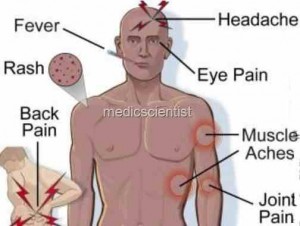Medi Services

Typhoid fever is an acute illness associated with fever caused by theSalmonella typhi bacteria. It can also be caused by Salmonella paratyphi, a related bacterium that usually causes a less severe illness. The bacteria are deposited in water or food by a human carrier and are then spread to other people in the area.
Typhoid fever is contracted by drinking or eating the bacteria in contaminated food or water. People with acute illness can contaminate the surrounding water supply through stool, which contains a high concentration of the bacteria. Contamination of the water supply can, in turn, taint the food supply. The bacteria can survive for weeks in water or dried sewage.
About 3%-5% of people become carriers of the bacteria after the acute illness. Others suffer a very mild illness that goes unrecognized. These people may become long-term carriers of the bacteria -- even though they have no symptoms -- and be the source of new outbreaks of typhoid fever for many years.
After the ingestion of contaminated food or water, the Salmonellabacteria invade the small intestine and enter the bloodstream temporarily. The bacteria are carried by white blood cells in the liver,spleen, and bone marrow, where they multiply and reenter the bloodstream. People develop symptoms, including fever, at this point. Bacteria invade the gallbladder, biliary system, and the lymphatic tissue of the bowel. Here, they multiply in high numbers. The bacteria pass into the intestinal tract and can be identified in stool samples. If a test result isn't clear, blood samples will be taken to make a diagnosis.
The incubation period is usually 1-2 weeks, and the duration of the illness is about 3-4 weeks. Symptoms include:
Chest congestion develops in many people, and abdominal pain and discomfort are common. The fever becomes constant. Improvement occurs in the third and fourth week in those without complications. About 10% of people have recurrent symptoms after feeling better for one to two weeks. Relapses are actually more common in individuals treated with antibiotics.
After the ingestion of contaminated food or water, the Salmonellabacteria invade the small intestine and enter the bloodstream temporarily. The bacteria are carried by white blood cells in the liver,spleen, and bone marrow, where they multiply and reenter the bloodstream. People develop symptoms, including fever, at this point. Bacteria invade the gallbladder, biliary system, and the lymphatic tissue of the bowel. Here, they multiply in high numbers. The bacteria pass into the intestinal tract and can be identified in stool samples. If a test result isn't clear, blood samples will be taken to make a diagnosis.




